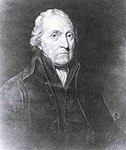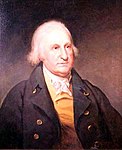1802–03 United States Senate elections
The 1802–03 United States Senate elections were held on various dates in various states. As these U.S. Senate elections were prior to the ratification of the Seventeenth Amendment in 1913, senators were chosen by state legislatures. Senators were elected over a wide range of time throughout 1802 and 1803, and a seat may have been filled months late or remained vacant due to legislative deadlock.[1] In these elections, terms were up for the senators in Class 1.
| ||||||||||||||||||||||
11 of the 32 seats in the United States Senate (plus special elections) 17 seats needed for a majority | ||||||||||||||||||||||
|---|---|---|---|---|---|---|---|---|---|---|---|---|---|---|---|---|---|---|---|---|---|---|
| ||||||||||||||||||||||
 Results: Dem-Republican hold Dem-Republican gain Federalist hold Legislature failed to elect | ||||||||||||||||||||||
| ||||||||||||||||||||||
The Democratic-Republican Party maintained and greatly expanded their majority of seats to over two-thirds of the Senate.
Change in composition
Before the elections
Accounting for the 1802 special elections in New York, Rhode Island, and South Carolina.
| DR6 | DR5 | DR4 | DR3 | DR2 S.C. (sp) Hold | DR1 N.Y. (sp) Hold | ||||
| DR7 | DR8 | DR9 | DR10 | DR11 | DR12 | DR13 | DR14 | DR15 | DR16 Va. (reg) Ran |
| Majority → | DR17 Tenn. Unknown | ||||||||
| F7 Conn. Ran | F8 Del. Ran | F9 Md. Ran | F10 N.J. (reg) Ran | F11 N.Y. (reg) Ran | F12 Vt. Ran | F13 R.I. Retired | F14 Pa. Retired | F15 Mass. Retired | |
| F6 | F5 | F4 | F3 | F2 | F1 R.I. (sp) Hold | ||||
Result of the regular elections
| DR6 | DR5 | DR4 | DR3 | DR2 | DR1 | ||||
| DR7 | DR8 | DR9 | DR10 | DR11 | DR12 | DR13 | DR14 | DR15 | DR16 Md. Re-elected |
| Majority → | DR17 N.Y. (reg) Gain | ||||||||
| F7 Conn. Re-elected | F8 Del. Re-elected | F9 Mass. Hold | V1 N.J. (reg) Fed loss | V2 Tenn. DR loss | DR21 Va. (reg) Gain | DR20 Vt. Gain | DR19 R.I. Gain | DR18 Pa. Gain | |
| F6 | F5 | F4 | F3 | F2 | F1 | ||||
Beginning of the first session, October 17, 1803
| DR7 | DR6 | DR5 | DR4 | DR3 | DR2 | DR1 | |||
| DR8 | DR9 | DR10 | DR11 | DR12 | DR13 | DR14 | DR15 | DR16 | DR17 |
| Majority → | DR18 | ||||||||
| F8 | F9 | DR25 Ohio New state | DR24 Ohio New state | DR23 N.J. (reg) Appointee elected | DR22 Tenn. Re-elected | DR21 | DR20 | DR19 | |
| F7 | F6 | F5 | F4 | F3 | F2 | F1 | |||
| Key: |
|
|---|
Race summaries
Unless noted, the number following candidates is the whole number vote(s), not a percentage.
Special elections during the 7th Congress
In these special elections, the winner was seated before March 4, 1803; ordered by election date.
| State | Incumbent | Results | Candidates | ||
|---|---|---|---|---|---|
| Senator | Party | Electoral history | |||
| New York (Class 3) | John Armstrong, Jr. | Democratic-Republican | 1800 (special) | Incumbent resigned February 5, 1802. Winner elected February 11, 1802. Democratic-Republican hold. |
|
| New Hampshire (Class 3) | James Sheafe | Federalist | 1800 | Incumbent resigned June 14, 1802. Winner elected June 17, 1802. Federalist hold. |
|
| South Carolina (Class 3) | John E. Colhoun | Democratic-Republican | 1800 | Incumbent died October 26, 1802. Winner elected November 4, 1802. Democratic-Republican hold. |
|
Races leading to the 8th Congress
In these regular elections, the winner was seated on March 4, 1803; ordered by state.
All of the elections involved the Class 1 seats.
| State | Incumbent | Results | Candidates | ||
|---|---|---|---|---|---|
| Senator | Party | Electoral history | |||
| Connecticut | James Hillhouse | Federalist | 1796 | Incumbent re-elected October 27, 1802. |
|
| Delaware | Samuel White | Federalist | 1801 (Appointed) | Incumbent re-elected January 11, 1803. |
|
| Maryland | John E. Howard | Federalist | 1796 (special) 1796 | Incumbent lost re-election. New senator elected November 17, 1802. Democratic-Republican gain. |
|
| Massachusetts | Jonathan Mason | Federalist | 1800 (special) | Incumbent retired. New senator elected February 7, 1803, on the fourth ballot. Federalist hold. |
|
| New Jersey | Aaron Ogden | Federalist | 1801 (special) | Incumbent lost re-election. Legislature failed to elect. Federalist loss. |
|
| New York | Gouverneur Morris | Federalist | 1800 (special) | Incumbent lost re-election. New senator elected February 1, 1803, on the 2nd ballot. Democratic-Republican gain. |
|
| Pennsylvania | James Ross | Federalist | 1794 (special) 1797 | Incumbent retired. New senator elected December 14, 1802. Democratic-Republican gain. |
|
| Rhode Island | Theodore Foster | Federalist | 1796 | Incumbent retired. New senator elected in 1802. Democratic-Republican gain. |
|
| Tennessee | Joseph Anderson | Democratic- Republican | 1799 (special) | Legislature did not elect until September 22, 1803, after the term began, see below.[citation needed] Democratic-Republican loss. | None. |
| Vermont | Nathaniel Chipman | Federalist | 1797 (special) | Incumbent lost re-election. New senator elected in 1802. Democratic-Republican gain. |
|
| Virginia | Stevens Mason | Democratic- Republican | 1794 (special) 1796 | Incumbent re-elected in 1803. |
|
Special elections during the 8th Congress
In this special election, the winner was seated in 1803 after March 4.
| State | Incumbent | Results | Candidates | ||
|---|---|---|---|---|---|
| Senator | Party | Electoral history | |||
| Ohio (Class 1) | New seat | Ohio joined the Union in 1803. Winner elected April 1, 1803. Democratic-Republican gain. |
| ||
| Ohio (Class 3) | New seat | Ohio joined the Union in 1803. Winner elected April 1, 1803. Democratic-Republican gain. |
| ||
| Tennessee (Class 1) | Vacant | Legislature had failed to elect.[citation needed] Predecessor re-elected late September 22, 1803 on the 4th ballot. Democratic-Republican gain. |
| ||
| New Jersey (Class 1) | John Condit | Democratic-Republican | 1803 (Appointed) | Legislature had failed to elect. Condit was then appointed September 1, 1803, to continue the term. He was then elected November 3, 1803. |
|
| Virginia (Class 1) | John Taylor | Democratic-Republican | 1792 (special) 1793 | Predecessor Stevens T. Mason (DR) had died May 10, 1803, having just begun the new term. Interim appointee served from June 4, 1803, and did not seek election to finish the term. Winner elected December 7, 1803. Democratic-Republican hold. |
|
Early race leading to the Congress-after-next
In this regular election, the winner was seated on March 4, 1805; ordered by state.
This election involved a Class 2 seat.
| State | Incumbent | Results | Candidates | ||
|---|---|---|---|---|---|
| Senator | Party | Electoral history | |||
| Tennessee | William Cocke | Democratic- Republican | 1799 (special) | Incumbent retired. New senator elected early September 23, 1803. Democratic-Republican hold. |
|
Connecticut
Federalist incumbent James Hillhouse (originally elected in 1796) was re-elected.
Delaware
Maryland
| ||||||||||||||||
80 members of the Maryland General Assembly | ||||||||||||||||
|---|---|---|---|---|---|---|---|---|---|---|---|---|---|---|---|---|
| ||||||||||||||||
Samuel Smith won election over John Eager Howard by a margin of 21.05%, or 16 votes, for the Class 1 seat.[18]
Massachusetts
New Hampshire (special)
New Jersey

There were two elections to the class 1 seat.
New Jersey (regular)
The New Jersey legislature failed to elect by the March 4, 1803, beginning of the term.
New Jersey (special)
The governor appointed Democratic-Republican John Condit September 1, 1803, to continue the term. Condit was then unanimously elected November 3, 1803, to finish the term. No vote totals were recorded.[19]
New York
New York (special)

Democratic-Republican John Armstrong Jr., who had held the class 3 seat since 1801, resigned February 5, 1802, and Democratic-Republican DeWitt Clinton was elected February 23, 1802, to finish the term. Clinton, however, resigned November 4, 1803, and Armstrong was appointed December 8, 1803, to his old seat.
New York (regular)

Federalist Gouverneur Morris lost re-election to the class 1 seat to Democratic-Republican Theodorus Bailey in 1803.
Ohio
Ohio joined the Union in 1803. New Democratic-Republican senators were elected April 1, 1803. Official records indicate that John Smith and Thomas Worthington were elected, and that Smith received the "long" term, while Worthington received the "short" one. They do not indicate if there were other candidates, or what the vote totals were.[20]
Pennsylvania
Rhode Island
South Carolina (special)
Tennessee
Vermont
Federalist Senator Nathaniel Chipman lost re-election to Democratic-Republican Israel Smith. Smith received 102 votes in the Vermont House of Representatives and 9 from the Governor and Council.[12] Spencer received 75 votes from the House and 4 from the Governor and Council.[12]
Virginia
There were two elections to the same seat as the newly-re-elected senator died at the beginning of the next term.
Virginia (regular)
Two-term Democratic-Republican Stevens Mason was re-elected in 1803.
Virginia (special)

Mason died May 10, 1803, having just begun the new term. Democratic-Republican John Taylor was appointed but chose not to run to finish the term. Democratic-Republican Abraham B. Venable was elected December 7, 1803, as the unanimous choice of the Virginia General Assembly. No vote totals were recorded.[16]
See also
References
Sources
- Party Division in the Senate, 1789-Present, via Senate.gov


